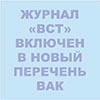Number 4 / 2017
To download all number in format PDF (in Russian)The further text is accessible on a paid subscription.
For authorisation enter the login/password.
Or subscribe
Number maintenance (pdf) (doc)
Number abstract (doc)
Literature lists to articles (doc)
|
bbk 000000
UDC 504.06
Skryabin A. Yu., Popovian G. V., Tron' I. A.
Study of the factors effecting the intensive growth of microalgae in the Don River
Summary
The factors enhancing the growth and evolution of the microalgae species composition in the Don River were studied. The effect of phosphorus on the phytoplankton growth rate was proved. The sources of nutrients incoming to the water bodies were analyzed. The factors of anthropogenic eutrophication of water bodies are presented: dyke construction facilitating the reduction of the river flow rate; decay of the vegetation on the lands immersed during the construction of water reservoirs and canals; intensive development of industrial production, agricultural activities, cattle breeding; increase of household and industrial use of synthetic detergents. The strategy of controlling water source bloom is proposed: bloom suppression during its development directly in the water body; the use of biological treatment methods (rehabilitation of the natural biocenosis by seeding certain microalgae species – different Chlorella strains and some species of herbivorous fish, e.g. silver carp; elimination of household and industrial use of phosphorus-containing detergents and their replacement with phosphate free detergents; strengthening of control of nitrogen and phosphorus fertilizer use in agriculture; construction and stepwise reconstruction or upgrade of wastewater treatment facilities that provide for enhanced removal of nitrogen and phosphorous compounds.
Key words
water supply , odor , nitrogen , phosphorous , phytoplankton , microalgae , geosmin , odor components , surface water source
Read more ...
|
bbk 000000
XII Международная научно-техническая конференция, посвященная памяти академика РАН Сергея Васильевича Яковлева
Аннотация
С 15 по 17 марта 2017 г. в ФГБОУ ВО «Национальный исследовательский Московский государственный строительный университет» прошла XII Международная научно-техническая конференция, посвященная памяти академика Российской академии наук С. В. Яковлева.
Ключевые слова
Read more ...
|
bbk 000000
UDC 628.16:62-278
SHVETSOV V. N., MOROZOVA K. M., FESENKO L. N., Kostyukov V. P., Vergunov A. I.
Biosorption-membrane reactor with flat filtering elements: the calculation method
Summary
The results of studying the Don River water purification with the use of biosorption-membrane method in a biosorption-membrane reactor with flat-frame filtering elements are presented. An experimental plant with a capacity of less than 2.7 m3/day with addition of powdered activated carbon was constructed at the Novocherkassk water treatment facilities. The specific flow through the membrane was less than 17.6 l/(m2·h). The experimental results showed the high efficiency of natural water purification in a biosorption-membrane reactor that provided for meeting the requirements of Sanitary Rules and Regulations (SanPiN). The efficiency of COD reduction averaged to 41.2%, color – 57.3%, permanganate value – 33.3%. During the entire experiment no suspended solids were found in permeate. The obtained data were used as a basis for calculating the specific rate of organics oxidation estimated by COD and permanganate value. The maximum values of Vmax oxidation rate and Km Michaelis constant were determined by graphical method of double reciprocal. The permanganate value dependence of the specific organics oxidation rate and COD from temperature was obtained. Temperature constant of Van Hoff’s equation was determined by COD and permanganate value to calculate the specific rate of organic pollutants oxidation during winter (10–11 °С) and summer seasons (20–22 °С). The method of calculating a biosorption-membrane reactor is presented.
Key words
powdery activated carbon , natural water treatment , biosorption membrane reactor , specific oxidation rate , biosorption , membrane filtration
Read more ...
|
bbk 000000
UDC 628.31:661.5
Stepanov S. V., Solkina O. S., MOROZOVA K. M., Stepanov A. S., Zhukova M. A.
The effect of membrane chemical washing on biological treatment processes
Summary
The results of research studies in the field of biomembrane treatment of dairy wastewater are presented. The experimental studies were carried out during four months. As a model effluent milk solution was used with addition of nutrients in the form of mineral salts – potassium monophosphate, ammonium chloride and sodium nitrate in ratios corresponding to the concentrations of these substances in original wastewater after physical and chemical treatment. The experiment was aiming at determining the process and kinetic characteristics of biological processes in a membrane bioreactor. The studies of the model wastewater in a pilot bioreactor showed that at 7–9 g/l sludge dosage and 0.36 m3/(m2·day) specific flow rate corresponding to the regular operation mode of flat-frame membranes the operation of the plant without chemical washing was possible for about two months. It was stated that membrane washing with citric acid at 1000 mg/l solution concentration (5–20 mg/l acid concentration in the membrane tank) provided for reducing the rate of biochemical processes with only mixed liquor acidification. The citric acid toxicity did not appear at mixed liquor pH in the range of 6.83–7.17. The study of membrane washing with sodium hypochlorite solution in concentration of 2000 mg/l as NaOCl showed the competitive inhibition of the organics oxidation rate with practically complete inhibition of biochemical processes at the active chlorine concentration in the reactor more than 26.1 mg/l. The time of restoring the original rate of organics oxidation at 6.6 mg/l active chlorine concentration in the reactor was 220 minutes after wastewater supply had been started and permeate had been removed.
Key words
biological treatment , membrane bioreactor , kinetic constant , dairy wastewater , membrane chemical washing , specific oxidation rate
Read more ...
|
bbk 000000
UDC 628.166.085
SMIRNOV A. D., Strelkov A. K., Tkachev A. A.
Revisiting the selection of wastewater disinfection technology
Summary
Environmental law enforcement in relation to discharging chlorine and organochlorine contaminants induces the use of advanced safe and efficient chlorine free methods of wastewater disinfection. The use of ultraviolet irradiation provides for meeting all the requirements imposed on the technology of wastewater disinfection eliminating any adverse impact on the environment. The use of this technology eliminates possible penalty charges for polluting the environment with chlorine and organochlorine contaminants. The economic comparison of two disinfection methods (the application of sodium hypochlorite and UV-irradiation) reveals significant operational benefit when introducing UV-disinfection. Annual savings of operational expenditures is 50% and more at the comparable capital expenditures. The advantages of UV-disinfection are as follows: efficiency in relation to all types of indicator and pathogenic microorganisms, whereas chlorine-containing chemicals do not often ensure fair efficiency in viruses and protozoa elimination; no by-products are generated; no adverse impact on the water bodies is produced (consequently, no penalties); no threat of overdosing; easy and simple control over the disinfection process; no need in dosing system and additional control systems; disinfection effect independence from fluctuations of effluents quality within the limits of the design parameters; minimum footprint; no additional facilities are needed (e. g., contact tank for dechlorination); possible retrofitting into the existing buildings or facilities, for example, in the process of wastewater treatment facilities upgrade and chlorination replacement; low operational expenditures (lamp replacing once in a year and a half – two years and energy saving). In this context switching to chlorine free disinfection technologies that eliminate the formation of organochlorine contaminants is a correct solution.
Key words
chlorination , disinfection , wastewater , dechlorination , ultraviolet irradiation , effluents charge
Read more ...
|
bbk 000000
UDC 628.31:628.38
Kofman V. Ya.
Improving the efficiency of water resources management: decentralized grey water treatment
Summary
The established over the course of decades strategy of municipal wastewater treatment needs to be revised since it is not oriented toward water reuse (instead of effluent discharge into the receiving waters); it is not designed for nutrients removal and demands significant expenditures for the removal of xenobiotics. The centralized wastewater treatment does not provide for the qualitative solution of the given problem. Overseas the concept of separate collection and decentralized treatment of concentrated black water containing urea and faeces and grey water containing bath, shower and sink water, water from washing machines and dishwashers, kitchen water has been rapidly developed. Grey water contains much less (compared to black water and municipal wastewater) xenobiotics and pathogens and can be a source of water of different purity levels. This approach predetermines more sustainable municipal water supply, in particular, by avoiding meeting all the demands from a single drinking water source, all the more in cases when there is no need in high-quality water. In USA, Japan, Australia, Israel, some EU countries studies of different scales are carried out; in practice different schemes of nonpotable use of grey water after the required treatment have been implemented.
Key words
grey water , decentralized treatment , treatment process flow schemes , xenobiotics , water reuse
Read more ...
|
bbk 000000
UDC 697.34
Rafal'skaia T. A., Mansurov R. Sh.
Evaluation of the water temperature in the hot water system effect on the indoor temperature conditions
Summary
In the modern centralized heat supply systems two breakpoints of the central control heating curve are used. According to the effective regulative documents on ensuring the quality of hot water the temperature of supplied hot water should be raised in order to improve its microbiological characteristics. For this purpose the lower breakpoint of the central control heating curve was raised. At the same time in view of the impossibility of maintaining high temperature heating curves of the heat sources the upper breakpoint of the heating curve is used. However in the present day schemes of heat supply stations coordinated heat supply to the systems of hot water and heat supply is used. The effect of temperature breakpoints on the indoor conditions was studied. A comparative checking calculation of the heating curves of a heat supply station in 2011–2012 was carried out when two breakpoints of the heating curve were used and in 2014–2015 when the upper breakpoint was raised (the lower breakpoint was raised too). The indoor temperature was determined with account of various building heat accumulation coefficients at different outdoor temperatures and variable water consumption in the hot water system. The calculations showed that raising the lower breakpoint produced more significant effect on the indoor heat conditions compared to the effect of raising the upper breakpoint. Raising the temperature in the hot water system can cause unfavorable heat conditions in the heated space; therefore raising the lower breakpoint cannot be considered as an energy efficient solution of the problem. Eliminating the drawbacks in the operation of hot water systems as well as carrying out regular thermal water disinfection can ensure meeting the requirements of the effective regulative documents eliminating deterioration of the heat supply quality.
Key words
hot water supply system , heat supply system , heating system , indoor heat conditions , heating curve of the central control , heat supply station , building heat accumulation coefficient
Read more ...
|
bbk 000000
UDC 628.1/.2:62-192
Alekseev M. I., Baranov L. A., Yermolin Yu. A.
Evaluation of water and wastewater facilities life time under the conditions of periodic failure flow
(to be discussed)
Summary
It is customary to evaluate the reliability of water and wastewater facilities by a number of indicators; the most important among them being the failure rate, reliability function – probability of failure free operation of a project by the time, average time between neighboring failures (life time) of the project. An approximate analytical solution of the task of the project reliability evaluation is presented for the case when the failure flow rate influencing the project is a periodic piecewise constant time function. It was suggested to replace this nonstationary process with a fictitious stationary one. The formula was derived stating the constant failure rate of the equivalent fictitious flow through the parameters of the initial real process. This provides for the possible approximate solution of reliability tasks in analytic form that is suitable for practical use and further analysis.
Key words
reliability , water supply-sewerage services , stationarity , failure flow intensity , project life time , equivalent replacement
Read more ...
|
bbk 000000
UDC 628.144:532.542
Baranchikova N. I., Yepifanov S. P., Zorkaltsev V. I., Kurtin A. V., Obuzdin S. Iu.
Flow distribution in water supply and distribution systems with automatic pressure regulators
Summary
The task of flow distribution in general pipeline systems including the systems of water supply and distribution with automatic pressure regulators is considered. To improve the reliability of the system operation pressure regulators are often installed «downstream» (reducing valves) and «upstream» (tank release valves). Pressure regulators manufactured by Bermad have been installed in the water distribution networks of Irkutsk; that provided for reducing and stabilizing the pressure in some zones. However zones exist that are supplied from several water pipelines with different pressure at the connection points, therefore sometimes complete closing of some regulators occurs (more often with small diameters) or flow reversal is possible, and the water flows through the regulator in the opposite direction. In this case the regulator fails to fulfill its function. Mathematical modeling of such situations is very important because it is them which significantly complicate the operation of the water supply and distribution systems. Mathematical models of automatic «upstream» and «downstream» pressure and pressure drop regulators are suggested with account of their version: normally open or normally closed. The mathematical formulation of the problem of flow distribution in the systems of water supply and distribution with pressure regulators is presented. The critical for the practice task of flow distribution in the pipelines with automatic regulators has been solved for the setting that describes different scenarios of the automatic regulators operation. A simple and efficient method of solving the set task of flow distribution that does not require derivation and has rapid enough convergence is suggested. On the basis of the numerical experiments it is fair to assume that the number of iterations moderately depends on the dimension of the problem (number of nodes and semicircular arcs), considerably depends on spread of hydraulic resistance values and to a lesser extent – node selection.
Key words
pressure , mathematical model , pipeline system , flow distribution , hydraulic head , systems of water supply and distribution
Read more ...
|
|







